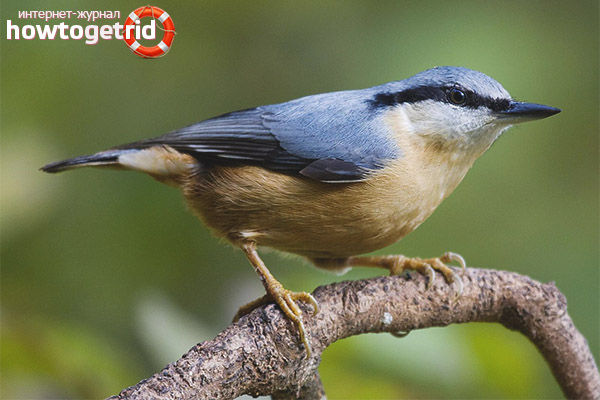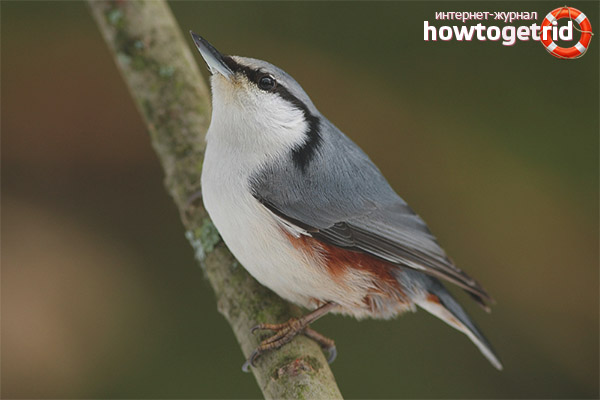The content of the article
The genus Passeriformes has many species of feathered representatives. But one noisy bird should pay special attention. This is a nuthatch. The bird is distributed on the territory of North America, as well as on the European and Asian continents. For all species, an external resemblance is characteristic. The differences are in the nature of the colors of the plumage and habitats. The anatomical structure of the bird’s legs is designed in such a way that they have good ability to move not only along the trunk of a tree, but even along the wall.
It’s somewhat unusual to watch a nuthatch running upside down on a wall. It is difficult to disagree with the fact that you will not see this often. The bird will attach its legs to the thin branch and hangs calmly upside down.
general description
The bird is characterized by a dense physique with an arrangement of a large head on the body. A short neck connects the head to the body. Nature awarded the bird with a beak in the form of a chisel. With the help of a strong direct beak, she pretty well hammering trees. The body is covered with loose plumage. It has a different color. At the top, it is gray. The color of the abdomen is very diverse. It can be of different colors with various shades, ranging from fawn and pumping a chestnut color.
The head is characterized by the presence of caps formed by dark feathers. The tail has contrasting white and black spots. Young people in comparison with adult birds have similar external data, but are distinguished by a dimmer plumage. In length, the body can reach 10 cm, and the mass does not go beyond 10 g. There are giant nuthatch, the dimensions of which have more significant dimensions.
By the method by which she procures her food, the nuthatch is similar to a woodpecker. Insects are extracted from under the bark. The bird hollows a tree, and the tail at this time is used by it as a support. The bird sits on the tree quite firmly. Strong paws with sharp claws help her in this. But not only the trees inhabit the bird. Sometimes, in order to study the litter, it can go down to the ground.
Some birds are characterized by the preparation of food for the winter. They hide seeds in various crevices and remember this place well. This bird does in case of bad weather, when finding food is quite problematic.
Prevalence
The distribution range of birds can be observed in the northern hemisphere, but this is most pronounced on the Asian continent. On European territory, they are distributed almost everywhere. This species can be found in all areas with a temperate climate. The habitats of some species of this feathered representative are North Africa, Algeria and Morocco.
Mostly impressed with a cool climate. Those that belong to the northern representatives are located on flat terrain, and for southern species mountains are preferable. In the total mass of birds are not prone to long flights. Only sometimes their bird life is associated with insignificant wanderings.
Birds live in forests with conifers, mountains, foothills. Some representatives are found in deciduous tree forests.
Characterization of Nuthatch Species
This genus has a large number of species representative of the feathered kingdom.
- Common Nuthatch. The species is represented by a small, very mobile bird, with a body length of slightly more than 14 cm and a weight of 25 g. The bird has a massive body composition, large head with an arrangement on a relatively short neck. The body is covered with thick and fluffy plumage. Color is determined by the habitat. The upper part is usually gray in color. In the southern regions, the body is red with a white chin. In the northern regions live birds with a white belly and a reddish color of the sides. The species is characterized by the presence of a long and straight beak. The wings are small, rounded in shape. The body ends with a short straight tail. The bird has very strong legs. The sizes of males are more significant in size in comparison with representatives of females.
- Baby Nuthatch. The bird does not exceed 10 cm in length, and the mass does not exceed 10 g. The color of the feathers is characterized by a bluish-gray hue. The body has a whitish tummy. There is a white spot on the occipital region. For habitat prefers coniferous forests. It occurs in the territory from the west of the USA to the central regions of Mexico.
- Corsican Nuthatch. This species can be found in the endemic territories of Corsica. The body does not exceed 12 cm in length. It passes into a small head with a short beak. On the back plumage with a bluish-gray color. The abdomen is gray or white. The male is characterized by the presence of a dark crown and bridle, while in the female they are gray. Young growth has a dull plumage, and this is how they differ from adults.
- Black-headed look. The hallmark of this species is the presence of red chest. The body is 12.5 cm long. The anatomical structure is characterized by the presence of small head sizes. Beak is small in size. The body has a bluish plumage. The abdomen is dirty white, and the chest is characterized by the presence of a red spot. The crown is characterized by a black color.
- Canadian Nuthatch. From the name it is easy to guess that the habitat is Canada. In addition, the bird is found in Alaska. The abdomen on the body has a reddish color. Face with white color and black stripes on the eyes. The beak is gray in color.
- Przewalski's Nuthatch. The bird has a small body length not exceeding 13 cm. Head with a dark nape. The body is purple. There are red shades of the breast and sides. It is found in China. It prefers coniferous forests located high in the mountains.
- Karolinsky view. It is found in North America. The body reaches 18 cm in length. The body weight can reach 40 g.
- Small rocky (rocky) view. In appearance, it bears a great resemblance to an ordinary nuthatch. Likes to be on the rocks. In addition, the bird likes to be on steep cliffs.
- Large rocky (rocky) view. The species is represented by a small bird with a body length of up to 16 cm and a mass of 55 g. The abdomen is white, and the back is with gray plumage.
- Black-headed Nuthatch. It is easy to guess that this species has a black spot on the forehead. The body in length does not exceed 12.5 cm. On the back there is a blue-violet plumage. The male has black eyebrows, which can not be seen in the female. Young individuals are characterized by a dull color. Preferred living in evergreen forests.
Differences between females and males
Propagation Features
The place of formation of the nest is hollow. Grass and leaves are carefully laid with birds in it. In addition, when using the nest, they also use bark, moss, wool and feathers.For the most part, the birds themselves do not hollow out the hollow in the tree, but use the existing education. But some do it on their own. They do not forget about safety measures. To do this, camouflage the entrance to the hollow using earth and clay.
Nuthatch is a typical monogamous. Birds become fertile in the first year of life. The female hatches from 4 to 14 eggs. They are stained with reddish or yellow color. Hatching continues for 12-18 days. The body of the chicks is covered in down. Chicks are fed by both parents. The chicks gain flying ability by the 25th day. But at first, they do not fly away from their parents. A few weeks later, they begin an independent bird life.
Video: Nuthatch (Sitta europaea)











Submit